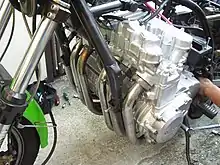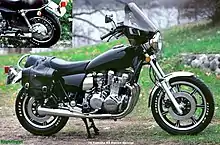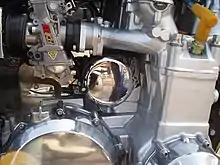Kawasaki Z1300
The Kawasaki Z1300 is a standard motorcycle unusual for its large-displacement 1,300 cc straight-six engine made by Kawasaki from 1979 to 1989.
.jpg.webp) Z1300 showing smooth engine water jacket and shaft drive to rear wheel | |
| Manufacturer | Kawasaki |
|---|---|
| Also called | KZ1300, ZG1300, ZN1300. |
| Parent company | Kawasaki Heavy Industries |
| Production | 1979-1989 |
| Class | Standard |
| Engine | 1,286 cc (78.5 cu in) 4-stroke DOHC water-cooled inline-6 with three Mikuni 32mm BSW32SS CV twin-choke carbs (1979 Z1300 A1 model)[1] |
| Bore / stroke | 62 mm × 71 mm (2.4 in × 2.8 in) |
| Top speed | 222 km/h (138 mph)[2] |
| Power | 89 kW (120 hp) @ 8,000 rpm (claimed)[2] |
| Torque | 115 N⋅m (85 ft⋅lb) @ 6,000 rpm (claimed)[2] |
| Transmission | Multi-disc wet clutch, 5-speed, shaft drive |
| Suspension | Front: telescopic air fork Rear: swingarm |
| Brakes | Front: 2× 300 mm (11.9 in) disc Rear: 270 mm (10.8 in) disc |
| Tires | Dunlop tubeless, Front: MN90-18 Rear: MT90-17 |
| Rake, trail | 28.5°, 100 mm (4.0 in) |
| Wheelbase | 1,660 mm (65.2 in) |
| Dimensions | H: 810 mm (32 in) |
| Seat height | 810 mm (32 in) |
| Weight | 314 kg (692 lb) (tank 1⁄2 full)[2] (wet) |
| Fuel capacity | 21 l; 4.7 imp gal (5.6 US gal) |
| Fuel consumption | 5.56 L/100 km; 50.8 mpg‑imp (42.3 mpg‑US)[2] |
Previously referring to the Z1300 as an Autobahn stormer,[3] when reviewing their 'Machine of the Year' competition results in 1979 after readers had voted for the Triumph Bonneville as the winner, UK weekly newspaper Motor Cycle News stated "Kawasaki, with their Z1300 — a superb example of technology by anyone's standards — have gone overboard in many people's minds."
Kawasaki Z1300 is a motorcycle launched by Kawasaki Heavy Industries Ltd. (KHI) in 1979. It was first released at the Cologne Motor Show in Germany in 1978, using a 120pz high horsepower and high durability shaft rotation design. This car has different names in different regions. (The European version is Z1300, but the North American version is KZ1300) These several versions of Z1300, such as KZ1300, ZG1300,[4] ZN1300, were produced between 1979 and 1989. In the United States, the KZ1300 also has a wagon version with a windshield and a side box, while in Europe, there is only a standard streetcar version. It caused a considerable sensation when it was launched because six-cylinder motorcycles are rare. Few motorcycles could match it at that time in terms of sheer power and speed. The core of Z1300 is the water-cooled, DOHC 24-valve parallel six-cylinder engine.
Kawasaki Z1300 was discontinued in 1989, and the last batch of cars was more than 30 years old. This motorcycle has become a classic in people's memory.
Performance
Kawasaki Z1300's length is 89.1 inches, and its width is 30.9 inches, its height: 49.8 inches, the wheelbase is 62.2 inches, seat height is 31.2 inches, ground clearance is 5.5 inches, weight is 314 kg.

The Z1300 had six cylinders, water cooling, and shaft drive. The undersquare stroke of 71 mm (2.8 in) and bore of 62 mm (2.4 in)kept the engine width acceptable, but the high piston speed limited the maximum rpm figure. During its ten-year production run, fuelling was switched from carburetors to electronic fuel injection and suspension was upgraded to air systems front and rear. Fuel injection system was adopted primarily to improve fuel consumption, but as a bonus were increased power and torque.
When released, its output in excess of 120 hp (89 kW) prompted France to introduce a 100 hp (75 kW) limit on new motorcycles.[5] However, no other EU country followed suit, and France is set to abolish the 100 bhp limit in 2016.[6]
Cycle World tested the 1979 KZ1300's 0 to 1⁄4 mile (0.00 to 0.40 km) time at 11.93 seconds at 114.79 mph (184.74 km/h) and 0 to 60 mph time at 4.01 seconds.[2]
Series
The Kawasaki Z1300 was manufactured in several versions, namely: Z1300, KZ1300, ZG1300 and ZN1300. It is the biggest model of the still-ongoing Z series that was started in 1972 with the Z1 (900). In the U.S., the model was equipped with a windshield, suitcase, and a redesigned frame. This new model was called "Voyager". In Europe, the traditional model was still available. The last 200 models (built in America as all Z1300 models were), built in 1989, have been called "Legendary Six", and were equipped with a special logo on the fuel tank to show that to the public. After a ten-year production run, Kawasaki's only liquid-cooled six-cylinder engine motorcycle was discontinued in 1989 after 20,000 KZ1300/Z1300 models and 4,500 Voyager models had been produced.
Contemporaneous competitors
Honda CBX1000
In 1978, Honda first introduced the CBX with up to 6 cylinders and a displacement of 1,047 ml, which started the competition between Z1300 and Honda CBX. This new flagship of the CB family has abandoned the single overhead camshaft of the early CB750 and replaced it with a DOHC suitable for high-speed and high-power; to satisfy the excellent appetite of parallel six-cylinders CBX is equipped with six carburettors to supply gasoline. Because the six cylinders are juxtaposed too wide, Honda engineers have spent much effort controlling the width, such as installing the magneto and ignition system behind the cylinders. Hence, the width of the parallel six cylinders is still within the acceptable range of more significant displacement, more cylinders and valves, to achieve more robust power performance. The maximum power of this parallel six-cylinder reaches 78 kW.[7]
For Honda's CBX1000 counterattack, Kawasaki did not hesitate to launch Kawasaki's first six-cylinder motorcycle. This is the parallel six-cylinder Z1300 with a displacement of 1286mL and a top speed of 220 km/h.[8]
.jpg.webp)
Yamaha XS11
XS Eleven (also call the XS1100) debuted in 1978 and was the largest capacity Yamaha produced at the time. It has become another strong competitor of Kawasaki Z1300. It has dual front disc brakes, rear disc brakes, shaft drive and cast wheels, but it only has a 4-cylinder engine, and the operation is more laborious and complicated. So compared to Z1300, its function and acceleration are slightly inferior.[9]

History
Brand History
Kawasaki Motorcycle's history began in the 1966. Kawasaki Motorcycle is a motorcycle produced by Kawasaki Heavy Industries' Motorcycle and Engine Division. Its first headquarters was located in an old meat warehouse, and started humble in the United States. Their initial focus was to realize their dreams and therefore did not focus on any fancy things to minimize management costs and use their finances for bicycle production. Three years after being listed in the United States, Kawasaki Motorcycle Company produced the Mach III 500cc two-stroke three-cylinder engine in 1969.[10] This was a major turning point for Kawasaki Motorcycle Company. This invention changed the rules of the game in the industry in terms of performance and successfully won the international market. Nowadays, it is a world-renowned motorcycle brand with factories in Japan, Michigan, Philippines, India, Indonesia, Bangladesh, and Thailand.[11]
Headquarters history
Kawasaki Heavy Industries, is a Japanese company with heavy industry as its primary business. Its business scope covers aviation, space, railway vehicles, motorcycles, ships, machinery, and various equipment. Has occupies a pivotal position in motorcycle brands and is also one of the four powerful motorcycles in Japan.[12]
Sbarro Super Twelve
In 1982, Swiss specialty car manufacturer Sbarro constructed a mid-engined sports car with hatchback bodywork called the Sbarro Super Twelve. The Super Twelve had an inline twelve-cylinder engine (a nominal straight-12) which consisted of two "joined" Z1300 engines.[13] The two engines were not a unit, as such, they were connected only by belt. Each engine kept its own gearbox and drove its own rear wheel. The car weighed 800 kg (1,764 lb) and produced 240 bhp (179 kW; 243 PS). Performance was described as "ferocious". Only one was ever built.[14]
Millyard Z2300 V-12
In 2008, noted British engineer and motorcycle customizer Allen Millyard built a one-off 2300 cc version of the Z1300 by joining two Z1300 engines together in a V-12 configuration.[15] Although Z1300 weight is more than 300 kg, this powerful heart takes less than 12 seconds to accelerate from 0 to 400 meters, and the top speed can reach 220 km/h. Together with the Honda CBX, Suzuki GS1000 and Yamaha XS1100 in the same period, it is described as a "superbike." for their extreme size and performance for the time.
Malpractice and maintenance method
Maintenance of the Z1300s is relatively easy. Due to the upgrade of the ignition system, Therefore, the valve clearance needs to be checked regularly, but it is rarely necessary to change the gasket before 10,000 miles. The carburettor on these machines requires regular balance checks to ensure fuel economy and performance.

Because the Z1300 has transformed into a 6-cylinder engine across the ages. 6-cylinder machines are unmatched by the increase in speed and diversification of design, more robust power, and smoother vibration. But things have two sides. Once a failure occurs, multi-cylinders are more troublesome than single-cylinders, so maintenance is more troublesome and difficult. Although the six-cylinder engine of the Z1300 is excellent, the eagerness for the whole bike leads to a heavy riding experience and high fuel consumption. Although its straight-six engine was smooth, the motorcycle was heavy, expensive and not fuel efficient, and the Z1300 sold poorly, particularly in Europe. A retrospective review from 2014 said the handling "wallowed, weaved and bucked", and its fuel economy was 9.4 L/100 km; 25 mpg‑US (30 mpg‑imp).[16] The emergence of multi-cylinders is an improvement and evolution due to the limited output power of a single cylinder. Rather than judging which is better and worse, it is better to regard it as a need for competition among various manufacturers. Kawasaki experienced some oil system problems on the early Z1300 (on the A2 engine number KZT30A-006201, the oil pan volume increased from 4.5 to 6 litres).[17]
See also
References
- Motorcycle Sport (UK magazine) July 1979 pp.364-365, 378-381 Analysis of the six-cylinder flagship of the Kawasaki range Retrieved 2015-02-04
- "Cycle World Test: Kawasaki KZ1300", Cycle World, Newport Beach, California: Hachette Filipacchi Media U.S., pp. 35–42, April 1979, ISSN 0011-4286
- Motor Cycle News 10 October 1979, p.5 It's your last chance to VOTE for your machine of the year. "Kawasaki are fielding a strong new team for the title captained by the six cylinder Z1300 Autobahn stormer...". Accessed and added 2015-03-03
- "Kawasaki ZG1300 information". www.cmsnl.com. Retrieved 2022-01-03.
- turnbackcaferacer (2016-07-23). "Kawasaki Z1300 Legend Of 6 Cylinder". Turn Back Cafe Racer. Retrieved 2022-01-03.
- "French 100bhp limit to be revoked - Motorcycle news: Industry - Visordown". visordown.com. Retrieved 2014-09-03.
- BowenTue, Simon; Jan 2011, 18. "Classic Scrap: Honda CBX1000 vs. Kawasaki Z1300". Visordown. Retrieved 2022-01-04.
{{cite web}}: CS1 maint: numeric names: authors list (link) - Walker, Mick (2013-01-20). British Motorcycles of the 1960s and '70s. Bloomsbury Publishing. ISBN 978-0-7478-1104-6.
- "Motorcycle Classics". Motorcycle Classics. Retrieved 2022-01-04.
- Jessica. "Kawasaki Motorcycles: 6 Things We Bet You Didn't Know". Retrieved 2022-01-03.
- "Leitor de PDF | Adobe Acrobat Reader DC". www.adobe.com (in Portuguese). Retrieved 2022-01-03.
- "Kawasaki Heavy Industries, Ltd. | Japanese manufacturer | Britannica". www.britannica.com. Retrieved 2022-01-03.
- Mazzocchi, Gianni, ed. (April 1984). "Autonotizie: Per lo Svizzero Sbarro questa è una ≪Ferrari≫!" [Car News: To Switzerland's Sbarro, this is a Ferrari!]. Quattroruote (in Italian). Milan, Italy: Editoriale Domus. 29 (342): 102.
- Philippe CALVET. "Sbarro Super Twelve, 1981". sbarro.perso.neuf.fr. Retrieved 2014-09-03.
- Brown, Roland. "Homebuilt Kawasaki 2300cc V-12 Motorcycle". Motorcyclist magazine. Retrieved 2016-08-02.
- "Kawasaki Z1300", RealClassic.co.uk, The Cosmic Motorcycle Co. Ltd/Redleg Interactive Media, archived from the original on October 8, 2018, retrieved 2014-09-03
- Kawasaki Voyager Z1300 Motorcycle Service Manual Supplement. Kawasaki Heavy Industries. 1983.